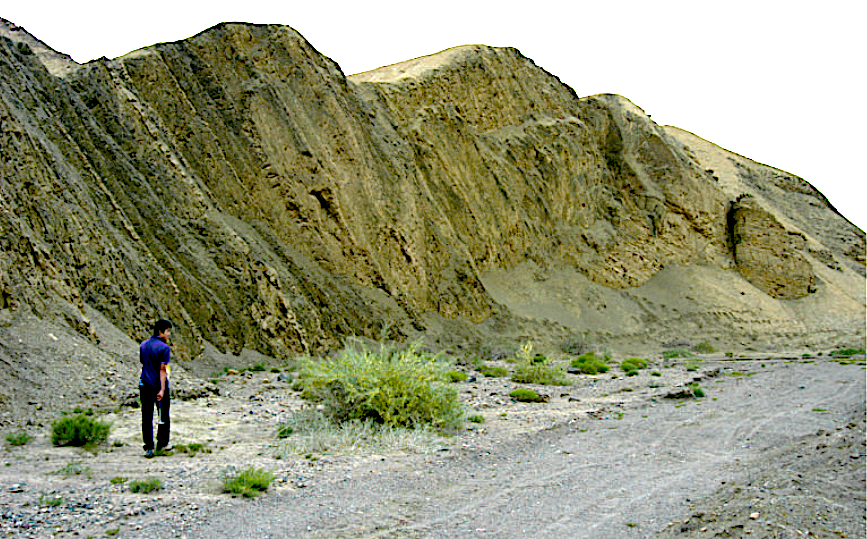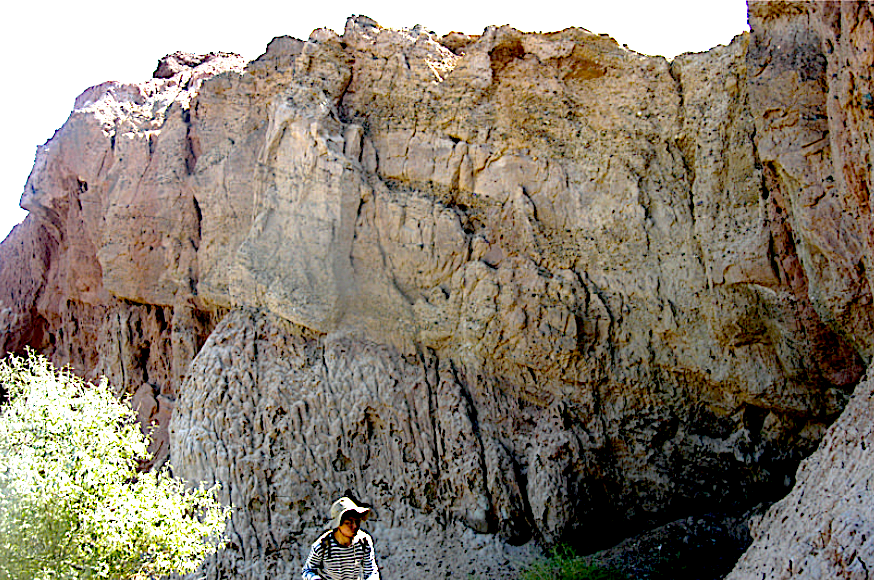Xiagou Fm
Type Locality and Naming
Jiuquan Basin. The Xiagou Formation was erected by the Gansu Geomechanical Regional Survey Team in 1976. The section for the designation is at the Xiagou Village on the east side of Xiagou of Qingquan township of the Yumen City, Gansu (97°48′20″E; 39°58′N). Middle formation in Xinminpu Gr.
Synonym: The Diwopu Fm is synonymous with the present formation.
Lithology and Thickness
The lower part of the Xiagou Formation is represented by mainly yellowish green, grayish green and yellowish brown thin- to medium-bedded feldspathic greywacke and clayey siltstone interbedded with silty mudstone, with thin gypsum beds, while the upper part mainly gray green and purple red interbedded clayey siltstone, sandstone and conglomerate. The formation is 931.4 m thick.
[Figure: Xiagou Formation in Xinminbao section of northern Qilian Mountain, Gansu]
[Figure: Xiagou Formation in Changma section of northern Qilian Mountain, Gansu]
Relationships and Distribution
Lower contact
The top and base of the formation are not exposed completely in the type section. The present formation may lie conformably on the Chijinpao Fm or unconformably on the Triassic Nanyinger Fm, the Xidagou Fm or even older strata.
Upper contact
Not exposed at type section. Conformable with Zhonggou Fm conglomerates elsewhere in basin.
Regional extent
The present formation is mainly distributed in Hongliuxia, Chijinbao and Xinminbao of the west Qilian Mountain and in the Beishan area, and is mostly developed in the western part of the Jiuquan basin. It is also exposed in Ejin Qi of west Inner Mongolia and in the Qilian County of Qinghai. On the western side of Xiagou of Gansu, the lower part of the formation is built up by purple red and gray green thick-bedded conglomerate interbedded with clayey sandstone, while the upper part gray green, yellow green and purple red mudstone, clayey siltstone and sandstone interbeds of different thicknesses, with marl. The base of the formation lies disconformably on the underlying Chijinpu Formation, while the top lies conformably under the overlying Zhonggou Fm. In Hongliuxia, it contains a large number of conglomerate beds and it forms coarse-fine-coarse sedimentary cycles. In Hanxia there appear andesite-basalt partings. In the Amuwusu area of Ejin of Inner Mongolia, it is represented by gray and yellow brown silty mudstone and siltstone interbeds of different thicknesses, intercalated with limestone, gypsum beds and siderites, with arkose and greywacke being developed in the upper part, measuring about 1234 m in thickness and belonging to fluvial-lacustrine deposition. In the Wulanaobao area of Peiling, it is intercalated with hematite nodules. Within the boundary of Qinghai, it varies considerably in lithology, and increases in the amount of sandstone and in thickness and decreases in the amount of conglomerate from west to east. It bears gypsum beds with volcanic rocks, granite, ultrabasic rock, quartz and hematite, and is 514-3623 m thick. It belongs to piedmont-fluvial and lacustrine deposition.
GeoJSON
Fossils
The formation yields bivalves Sphaerium jeholensis and S. aff. selenginense; gastropods Probaicalia vitimensis; estheria Lixianentheria ovata, Eosestheria aff. middendofii, Diestheria yixianensis; ostracods Cypridea (Morinina) occolota, Ziziphocypris costata, Darwinula contractra; Pisces Jiuquanichthys liui, Ikechaeamia orientalis; insects Ephemeropsis trisetalis, Coptoclava longipoda, Jiuquanocupes punctate, Mesoscabaeus brunneus, Clypostemma xyphiale, Mesonecrotaulius gansuense, Yumenocoleus lineatos, Y. cladotos, Mesoendipes gregaria; Charophytes Aclisehava hungarica, Aclistoehara lata, A. caii, Charites xiagouensis, Tolypella stipitata and floras; on the western side of Xiagou it also yields Reptilia Noripterus complicidens; bivalves Sphaerium selenginense, Ferganoconcha sibirica, F. cf. subcentralis, Tetoriafuxinensis, T. yodoyamai, Corbicula (Mesocorbicula) tetoriensis, C. (M.) ciaonincynsis; estheria Orthestheria hongliugedaensis, Dictyestheria qianlouziensis, Neodiestheria dolaziensis, Yanjiestheria sinensis, Y. yumensis, Changma shenjcawanensis; floras Ruffordia goepperti, Bruchyphyllum japonicum, Ginkgoites sibiricus; and sporopollen grains represented by the Densoisporites- Classopollis- Retitricolpites assemblage.
Age
Depositional setting
It belongs to piedmont-lacustrine deposition.
Additional Information

